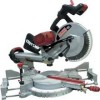Craftsman 21221 Operation Manual - Page 184
with the travel of the blade or the part
 |
View all Craftsman 21221 manuals
Add to My Manuals
Save this manual to your list of manuals |
Page 184 highlights
POSITIVE STOP LOCKING LEVER Locks the miter saw at a preset positive stop for the desired miter angle. SWITCH HANDLE - The switch handle contains the trigger switch and the laser on/off switch. The blade is lowered into the workpiece by pushing down on the handle. The saw will return to its upright position when the handle is released. WARNING LABELS - Read and understand for your own safety. Make sure all labels are present on machine and legible. WRENCH STORAGE - Convenient storage to prevent misplacing the blade wrench. WOODWORKING TERMS ARBOR - The shaft on which a blade is mounted. BEVEL CUT - An angle cut made through the face of the workpiece. COMPOUND CUT - An angled cut to both the edge and face of a board, most common use is with crown molding. CROSS CUT - A cut which runs across the board perpendicular to the grain. KICKBACK - Sudden and unintended movement of the tool or workpiece. It is typically caused by binding or pinching of the workpiece MITER CUT - A miter is a type of joint where the two parts to be joined are cut at an angle, and typically the finished joint forms a 90-degree angle. Also commonly spelled "mitre". REVOLUTIONS PER MINUTE (RPM) - The number of turns completed by a spinning object in one minute. SAW BLADE PATH - The area of the workpiece or table top directly in line with the travel of the blade or the part of the workpiece which will be cut. SET - The distance between two saw blade tips, bent outward in opposite directions to each other. The further apart the tips are, the greater the set. THIN-KERF BLADE - Thinner than normal blades, remove less material, smaller kerfs (between .065 and .070). Blade thinness also may increase the heat generated while cutting. WORKPIECE - The wood being cut. The surfaces of a workpiece are commonly referred to as faces, ends and edges. FREEHAND - Performing a cut without using a fence (guide), hold down or other proper device to prevent the workpiece from twisting during the cutting operation. HEEL - Misalignment of the blade. KERF - The width of a saw cut, determined by the thickness and set of the blade. 16















